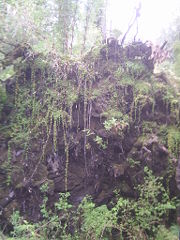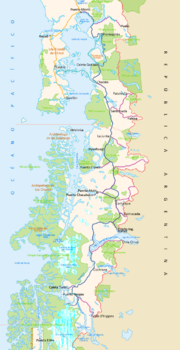
Pumalín Park
Encyclopedia


Palena Province
Palena Province is one of the four provinces in the southern Chilean region of Los Lagos . Due to the eruption of Chaitén Volcano and the subsequent destruction of Chaitén, Futaleufú is since March 2009 the new capital of Palena Province. The private Pumalín Park is located in the province as is...
of Chile
Chile
Chile ,officially the Republic of Chile , is a country in South America occupying a long, narrow coastal strip between the Andes mountains to the east and the Pacific Ocean to the west. It borders Peru to the north, Bolivia to the northeast, Argentina to the east, and the Drake Passage in the far...
, created by the United States environmental foundation The Conservation Land Trust, which is endowed and led by the American business magnate
Business magnate
A business magnate, sometimes referred to as a capitalist, czar, mogul, tycoon, baron, oligarch, or industrialist, is an informal term used to refer to an entrepreneur who has reached prominence and derived a notable amount of wealth from a particular industry .-Etymology:The word magnate itself...
Douglas Tompkins
Douglas Tompkins
Douglas Tompkins is an American environmentalist, conservationist and a former businessman.Tompkins co-founded and ran two clothing companies: the outdoor clothing company The North Face; and with his then-wife Susie, the ESPRIT clothing company. Since leaving the business world in 1989, Tompkins...
. Designated a Nature Sanctuary in 2005, Pumalin is Chile's largest private nature reserve and is operated as a public-access park, with an extensive infrastructure of trails, campgrounds, and visitor centers.
History
In 1991, Douglas Tompkins bought a large, semi-abandoned plot of land in the Reñihue RiverReñihue River
The Reñihue River is a river in the Palena Province of the Los Lagos Region in Chile.-Pumalín Park:The river flows through Pumalín Park, a privately owned and publicly accessible nature reserve owned by The Conservation Land Trust...
Valley of the Chilean province of Palena. A mountaineer and conservationist who had been visiting Patagonia since the early 1960s, Tompkins sought to protect the 16996.6 ha (41,999 acre) tract, most of which was primeval Valdivian temperate rainforest, from future exploitation. After moving to Reñihué to live full-time, Tompkins began developing plans for a larger park, gradually acquiring additional adjacent properties from willing sellers. Ultimately, roughly 98 percent of the park acreage was bought from absentee landowners.
The Conservation Land Trust subsequently added approximately 283280 ha (700,000 acre) in nearly contiguous parcels to form Pumalín Park, which was declared a Nature Sanctuary on August 19, 2005, by then-president Ricardo Lagos
Ricardo Lagos
Ricardo Froilán Lagos Escobar is a lawyer, economist and social democrat politician, who served as president of Chile from 2000 to 2006. He won the 1999-2000 presidential election by a narrow margin in a runoff over Independent Democrat Union candidate Joaquín Lavín...
. This special designation by the Chilean government grants the land additional protections to secure its ecological values and prevent development. The Conservation Land Trust later donated the protected lands to Fundación Pumalín, a Chilean foundation, for their administration and ongoing preservation as a national park under private initiative.
While nature-related philanthropy has a long tradition in the United States, large-scale private land acquisition for parks was unfamiliar in Chile, and initially generated skepticism and political opposition. Over the years of the project’s development, confidence has been built, both locally and nationally, as Pumalín Park’s public access infrastructure began serving thousands of visitors annually.
Biodiversity
One of Tompkins' central commitments is to preserving biodiversityBiodiversity
Biodiversity is the degree of variation of life forms within a given ecosystem, biome, or an entire planet. Biodiversity is a measure of the health of ecosystems. Biodiversity is in part a function of climate. In terrestrial habitats, tropical regions are typically rich whereas polar regions...
; the Pumalin conservation area not only provides visitors a spectacular wilderness experience, but also protects the area's threatened ecosystem and species. Although Chile lacks the faunal diversity of Amazon-area countries, it is rich in flora, with many endemic species and subspecies. The evergreen broadleaved forest, known in Chile as the Valdivian temperate rainforest, includes thousands of plant species. The annual rainfall in the coastal forests of Pumalín Park is approximately 6000 mm (236 in). These exceptionally wet, original forests reach all the way to the ocean, something that is increasingly rare worldwide. In addition, the park protects some of the last remaining stands of Alerce
Fitzroya
Fitzroya is a monotypic genus in the cypress family.-Species:The single living species, Fitzroya cupressoides, is a tall, long-lived conifer native to the Andes mountains of southern Chile and Argentina, where it is an important member of the Valdivian temperate rain forests...
trees, one of the oldest species on Earth.
The Park and the Local Economy
A ranger system, utilizing non-uniformed park rangers on the agricultural lands adjacent to the Nature Sanctuary, contributes to the park’s stewardship. Small organic farms with activities such as animal husbandry, cheesemaking, ecotourism, wool handicrafts, and honey production function simultaneously as park ranger stations and visitor information centers. In this way both conservation and a contribution to the local economy are achieved. The project is aware of the need to include neighbors of the park, to create a broad-based cultural appreciation for wilderness and biodiversity conservation, as well as demonstrating how an agrarian economy, carefully matched to local conditions, can help sustain biodiversity and create economic opportunity.Visiting Pumalin
One of the biggest ecotourist attractions of south Chile, Pumalin is accessible by car or boat. Caleta Gonzalo, at the center of the Park, in the Reñihue Fjord, houses the park's main tourist infrastructure, including a restaurant, visitor center, cabañas, and a campground. Ferries run from the village of Hornopiren to Caleta Gonzalo during the summer months.Since the 2008 eruption of the Chaitén Volcano, the park has been closed to visitors; it is predicted to reopen for the 2010-2011 season.
External links
- http://www.parquepumalin.cl Pumalín Park Official Website
- http://news.mongabay.com/2006/1027-george_black.html MongabayMongabayMongabay.com is a web site that publishes news on environmental science, energy and green design, and features extensive information on tropical rainforests, including pictures and deforestation statistics for countries of the world. Founded in 1999 by Rhett A...
news article about Pumalín Park - http://abcnews.go.com/Video/playerIndex?id=3295673 ABC NewsABC NewsABC News is the news gathering and broadcasting division of American broadcast television network ABC, a subsidiary of The Walt Disney Company...
nightly news broadcast profiling Pumalín Park on June 19, 2007

